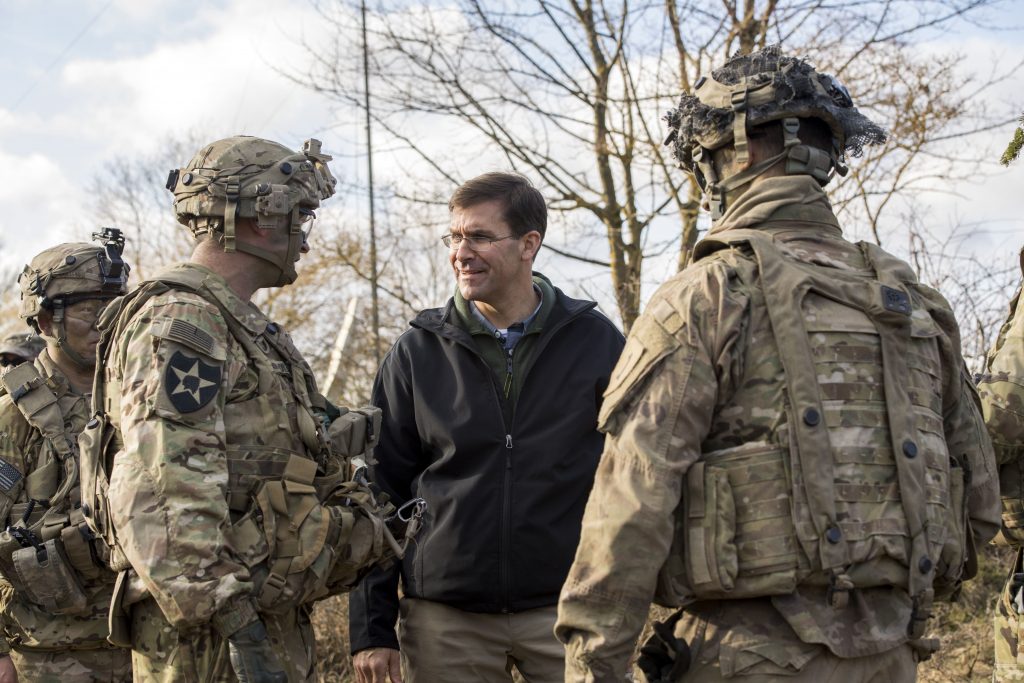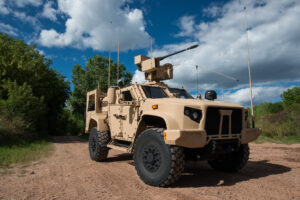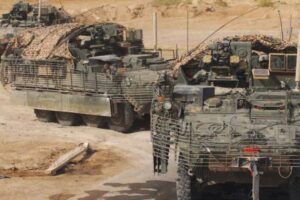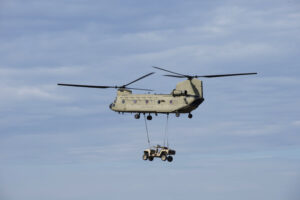Esper: Chinook & JLTV ‘Designed For a Different Conflict’
Posted on

Army Secretary Mark Esper talks with soldiers during exercises in Europe
PENTAGON: The Army appears likely to cut more funding from the Joint Light Tactical Vehicle program as the service pivots from counterinsurgency to staring down China and Russia.
The service’s top civilian painted the JLTV Tuesday as a product of the wars in Iraq and Afghanistan which might not be suited for potential future high-tech fights. Mark Esper placed it alongside other programs that started life before the 2018 National Defense Strategy.
“Now my emphasis has to be on rebuilding my armor, rebuilding my fighting vehicles, having aircraft that can penetrate Russian and Chinese air defenses,” Esper said. In those potential conflicts, the Army needs platforms “that can shoot down Russian and Chinese drones, and missiles, and helicopters and fixed-wing aircraft.”
The Army has already spent billions developing JLTV prototypes over a laborious 11-year development process — the program was first approved in 2006 — and has awarded production contracts worth billions more.

JLTV with 30 mm M230 chaingun (Oshkosh photo)
But last month, Army Undersecretary Ryan McCarthy confirmed the service wanted to cut $800 million — or about 1,500 to 1,800 vehicles — from its long-term plans for 49,000 JLTVs.
“We [already] took a cut out of JLTV,” Esper told a small group of reporters at the Pentagon Tuesday. “The question was, was that the final cut? The answer is ‘I don’t know.’”
The Army is currently working through a series of high-end war games that will update the service’s doctrine in light of the National Defense Strategy, which places near-peer conflict at the center of the Pentagon’s planning and spending efforts, as opposed to combating insurgents (COIN).
“We’re working through multi-domain operations right now,” Esper said, and if the war gamers “come out and tell us we don’t need as many [JLTVs], we’ve got to play all that out to see what the right number looks like…But I can’t tell you today whether the cut we made in this budget is the last one or not. I can’t give you that number. Events change, things change.”
Esper said the wargames should be done in about 18 months, after which “we run all the numbers and if these numbers tell you that to beat the Russians you need X tanks, and you need Y tankers, and then you need X number of JLTVs and that’s where I’ll have the final number.”
The first handful of JLTVs were shipped to the1st Armored Brigade Combat Team, 3rd Infantry Division at Fort Stewart, Georgia in January, but a series of Pentagon reports have called their effectiveness into question. The Army previously awarded a $6.7 billion contract to Oshkosh in 2015 to procure the initial 16,901 vehicles for the Army and Marines. In the fiscal 2020 request, the Army asked for another $1.6 billion for 4,090 additional vehicles.
Esper said that he still planned to buy some number of the trucks, confirming that the Army still plans to field a mix of Humvees and JLTVs in the future.
The new uncertainty surrounding what was at one point touted as the Army’s next-generation effort to replace the Humvee is part of a larger story within the Army, which is cutting legacy programs in order to shift tens of billions of dollars to other, more critical, modernization programs.

Strykers with slat armor in Afghanistan
Earlier this year, the service said it would stop procuring the newest “Block II” version of the CH-47 Chinook after fiscal year 2020.
[Click here to read about the Army’s ambivalence on Chinook]
The savings are part of an Army plan to shift $60 billion over the next five years to fund new priorities like long-range precision fires, the next-generation combat vehicle, Future Vertical Lift, the network, and air and missile defense efforts.
Esper singled out the CH-47 Block II program, saying it was scuttled because it — like the JLTV — was designed before the NDS and “before secretary Mattis issued his guidance” to invest in increasing lethality.

DAGOR sling-loaded under a CH-47 Chinook.
“Many of these programs in many ways were put in the context of Afghanistan and Iraq. Why the Block IIs? Gotta carry a heavier payload, gotta fly higher and hotter. What was the payload? JLTV. What drove the JLTV? IEDs in Afghanistan and Iraq.”
While the dangers of roadside bombs were one of the driving forces behind the Army and Marine Corps developing the JLTV during the height of the fighting in Iraq and Afghanistan, there are still thousands of US troops deployed overseas who deal with IEDs on a regular basis. Some 14,000 US troops remain in Afghanistan, 5,000 more are in Iraq, and a further 2,500 are still deployed in Syria. Just last week, three Marines were killed by an IED near Bagram outside Kabul. In northern Afghanistan in November, four other US soldiers were killed by an IED while on patrol.
But the Pentagon is eager to move beyond these fights, and into the world of great power competition with China and Russia.
Esper said programs like the Chinook Block II and the JLTV “were in many ways designed for a different conflict. Doesn’t mean we won’t use them in future conflicts,” but “we’re in this transition period and some folks are caught in that transition.”
Subscribe to our newsletter
Promotions, new products and sales. Directly to your inbox.
